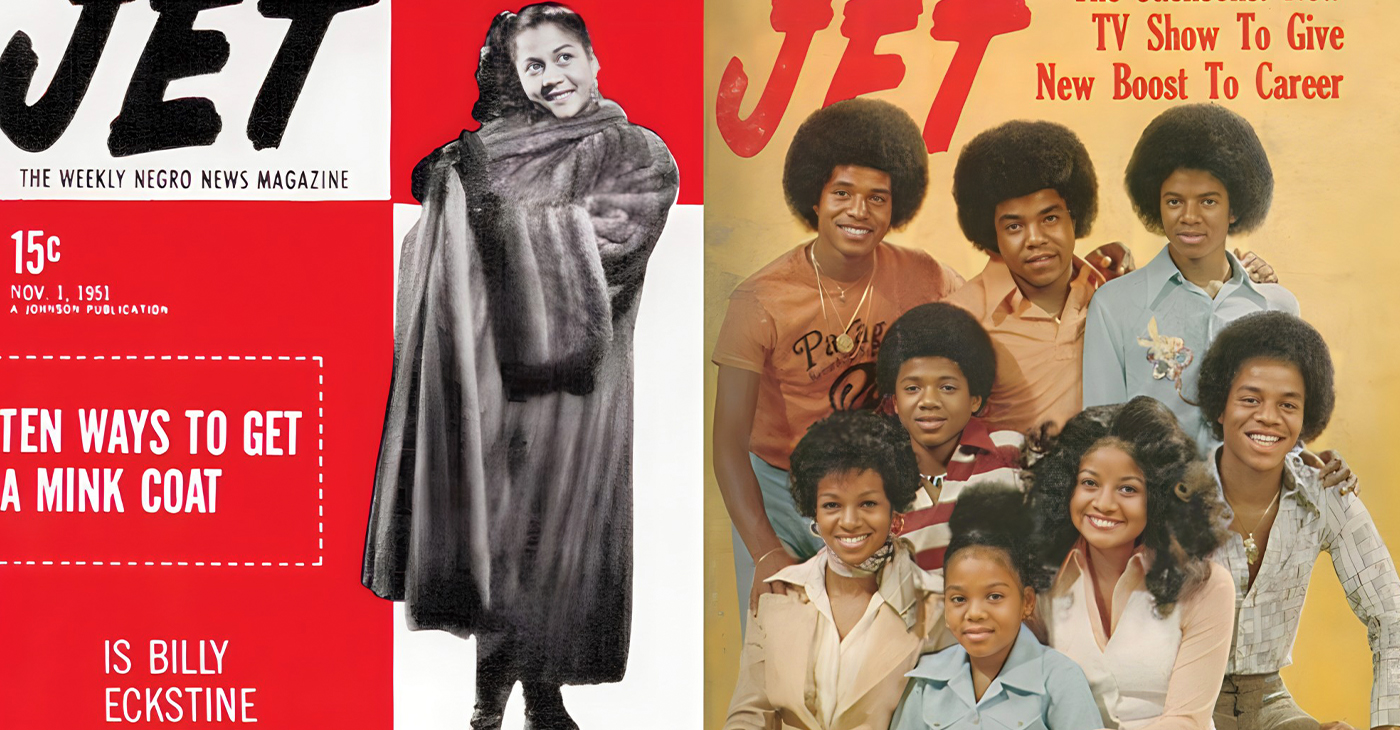Commentary
Re-Fueling Jet Magazine Where Everyone Can Be ‘Beauty of the Week’
Remember “Beauty of the Week,” Jet magazine’s famous page 43, which featured Black women college students, actors, nurses, and everyday girls in swimsuits? Now, anyone can be a beauty of the week or even grace the cover as the iconic publication re-sets digitally and where readers and fans can go to myjetstory.com and upload their photos and create a personalized Jet cover.

By Stacy M. Brown, NNPA Newswire Senior National Correspondent
@StacyBrownMedia
Remember “Beauty of the Week,” Jet magazine’s famous page 43, which featured Black women college students, actors, nurses, and everyday girls in swimsuits?
Now, anyone can be a beauty of the week or even grace the cover as the iconic publication re-sets digitally and where readers and fans can go to myjetstory.com and upload their photos and create a personalized Jet cover.
“Everybody has a Jet story,” Daylon Goff, the president of Jet, said during a 30-minute interview on the National Newspaper Publishers Association daily show, Let It Be Known.
“I’m always rocking Jet merchandise, and when someone finds out what I do for a living, they immediately give me their Jet story. Unprompted.”
For Goff, that’s all the fuel he needed to help in what he calls the re-set of Jet.
“It’s super exciting for me to be able to take this on,” Goff insisted.
“When you hear ‘Beauty of the Week,’ you don’t have to even say Jet beauty of the week. It’s synonymous. I get those conversations from both men and women at least three times a week.”
Founded in 1951 by John H. Johnson, Jet proved a mainstay in primarily Black households across America.
Like Ebony, founded six years earlier, Jet chronicled Black life in America and provided a lens into the African American community that mainstream media either ignored or misrepresented.
Goff recalled the disturbing but necessary images Jet published in 1955 of Emmett Till’s body after he was lynched and tortured.
“We had to be bold because you have that full ownership and understanding of the significance of that story,” Goff related.
“Jet was to the Emmett Till story what Twitter, Instagram, and Facebook live was to George Floyd. It started a movement. It wasn’t like little Black boys and men weren’t getting killed in Mississippi in 1955, but when you saw it on those pages, you felt you had to do something.
“The same way when you saw on social media George Floyd’s murder, you had to do something about it because it wasn’t as if before that moment, Black men weren’t getting killed by the police.”
While Jet told real stories about real people, most readers began with page 43.
With the re-set, Goff said one shouldn’t expect an immediate return of the Beauty of the Week.
“It was relatable and owned by our community,” Goff explained.
“The Beauty of the Week was a college student at Fayetteville, a nurse, secretary, or actress. Relatable people that we all thought were attainable. But how can we be relevant to our audience in a world that’s different and the way we consume information and get information?”
For instance, Goff wondered what would happen if Rihanna were chosen as the first beauty.
“Then Lizzo fans could say, what about her? And if we choose Lizzo, RuPaul could say, what about me?” Goff stated.
“People would have every right to say that Jet is saying ‘I’m not beautiful.’”
Indeed, Jet was social media before Instagram, Twitter, and Facebook.
Going viral in pre-social media days meant being on the cover of Jet.
Goff, whose background is brand marketing, understands that the Jet re-set is a challenging assignment.
But he’s thrilled to take it on.
“I call this being re-fueled by Jet. We can be relevant to our audience in a world that’s different, and the way we consume information and get information is different,” he stated.
“I also have to be relevant to an audience in a way that Ebony isn’t cannibalized. And we can do that. If we compare Ebony and Jet to iconic television characters, Ebony is Claire Huxtable, and Jet is Martin [Lawrence]. They both speak to the Black experience but in a different way.”
The key, Goff said, is figuring out how to keep Jet around for the next 70 or so years.
Basketball legend Charles Barkley still refers to Jet as the Black ‘bible,” Goff said, but the challenge is to ensure that a younger generation connects with the publication.
“Talking to 20 and 25-year-olds, I’m sometimes surprised that they are familiar with Jet,” Goff said.
“People never threw away Jet. They put them in boxes, and I’m sure there’s a ton in someone’s attic. You just had to hold on to them. There’s a spark from the younger generation; for me, it’s about igniting that spark.
“The great part about the next generation is that they also grew up with this computer in their pocket and can find and search for knowledge. So, we need to ensure that our iconic brands remain for years.”
Commentary
Opinion: Lessons for Current Student Protesters From a San Francisco State Strike Veteran
How the nation’s first College of Ethnic studies came about, bringing together Latino, African American and Asian American disciplines may offer some clues as to how to ease the current turmoil on American college campuses over the Israel-Hamas war. After the deadline passed to end the Columbia University encampment by 2 p.m. Monday, student protesters blockaded and occupied Hamilton Hall in a symbolic move early Tuesday morning. Protesters did the same in 1968.

By Emil Guillermo
How the nation’s first College of Ethnic studies came about, bringing together Latino, African American and Asian American disciplines may offer some clues as to how to ease the current turmoil on American college campuses over the Israel-Hamas war.
After the deadline passed to end the Columbia University encampment by 2 p.m. Monday, student protesters blockaded and occupied Hamilton Hall in a symbolic move early Tuesday morning.
Protesters did the same in 1968.
That made me think of San Francisco State University, 1968.
The news was filled with call backs to practically every student protest in the past six decades as arrests mounted into hundreds on nearly two dozen campuses around the country.
In 1970, the protests at Kent State were over the Vietnam War. Ohio National Guardsmen came in, opened fire, and killed four students.
Less than two weeks later that year, civil rights activists outside a dormitory at Jackson State were confronted by armed police. Two African American students were killed, twelve injured.
But again, I didn’t hear anyone mention San Francisco State University, 1968.
That protest addressed all the issues of the day and more. The student strike at SFSU was against the Vietnam war.
That final goal was eventually achieved, but there was violence, sparked mostly by “outside agitators,” who were confronted by police.
“People used the term ‘off the pigs’ but it was more rally rhetoric than a call to action (to actually kill police),” said Daniel Phil Gonzales, who was one of the strikers in 1968.
Gonzales, known as the go-to resource among Filipino American scholars for decades, went on to teach at what was the positive outcome of the strike, San Francisco State University’s College of Ethnic Studies. It’s believed to be the first of its kind in the nation. Gonzales recently retired after more than 50 years as professor.
As for today’s protests, Gonzales is dismayed that the students have constantly dealt with charges of antisemitism.
“It stymies conversation and encourages further polarization and the possibility of violent confrontation,” he said. “You’re going to be labeled pro-Hamas or pro-terrorist.”
That’s happening now. But we forget we are dealing not with Hamas proxies. We are dealing with students.
Gonzales said that was a key lesson at SF State’s strike. The main coalition driving the strike was aided by self-policing from inside of the movement. “That’s very difficult to maintain. Once you start this kind of activity, you don’t know who’s going to join,” he said.
Gonzales believes that in the current situation, there is a patch of humanity, common ground, where one can be both pro-Palestine and pro-Israel. He said it’s made difficult if you stand against the belligerent policies of Benjamin Netanyahu. In that case, you’re likely to be labeled antisemitic.
Despite that, Gonzales is in solidarity with the protesters and the people of Gaza, generally. Not Hamas. And he sees how most of the young people protesting are in shock at what he called the “duration of the absolute inhumane kind of persecution and prosecution of the Palestinians carried out by the Israeli government.”
As a survivor of campus protest decades ago, Gonzales offered some advice to the student protesters of 2024.
“You have to have a definable goal, but right now the path to that goal is unclear,” he said.
About the Author
Emil Guillermo is a journalist and commentator. A veteran newsman in TV and print, he is a former host of NPR’s “All Things Considered.”
Activism
Oakland Post: Week of May 1 – 7, 2024
The printed Weekly Edition of the Oakland Post: Week of May 1 – 7, 2024

To enlarge your view of this issue, use the slider, magnifying glass icon or full page icon in the lower right corner of the browser window. ![]()
Activism
Oakland Post: Week of April 24 – 30, 2024
The printed Weekly Edition of the Oakland Post: Week of April 24 – 30, 2024

To enlarge your view of this issue, use the slider, magnifying glass icon or full page icon in the lower right corner of the browser window. ![]()
-

 Community3 weeks ago
Community3 weeks agoFinancial Assistance Bill for Descendants of Enslaved Persons to Help Them Purchase, Own, or Maintain a Home
-

 Business3 weeks ago
Business3 weeks agoV.P. Kamala Harris: Americans With Criminal Records Will Soon Be Eligible for SBA Loans
-

 Activism4 weeks ago
Activism4 weeks agoOakland Post: Week of April 10 – 16, 2024
-

 Community3 weeks ago
Community3 weeks agoAG Bonta Says Oakland School Leaders Should Comply with State Laws to Avoid ‘Disparate Harm’ When Closing or Merging Schools
-

 Activism2 weeks ago
Activism2 weeks agoOakland Post: Week of April 24 – 30, 2024
-

 City Government3 days ago
City Government3 days agoCourt Throws Out Law That Allowed Californians to Build Duplexes, Triplexes and RDUs on Their Properties
-

 Community2 weeks ago
Community2 weeks agoRichmond Nonprofit Helps Ex-Felons Get Back on Their Feet
-

 Community2 weeks ago
Community2 weeks agoOakland WNBA Player to be Inducted Into Hall of Fame






















































